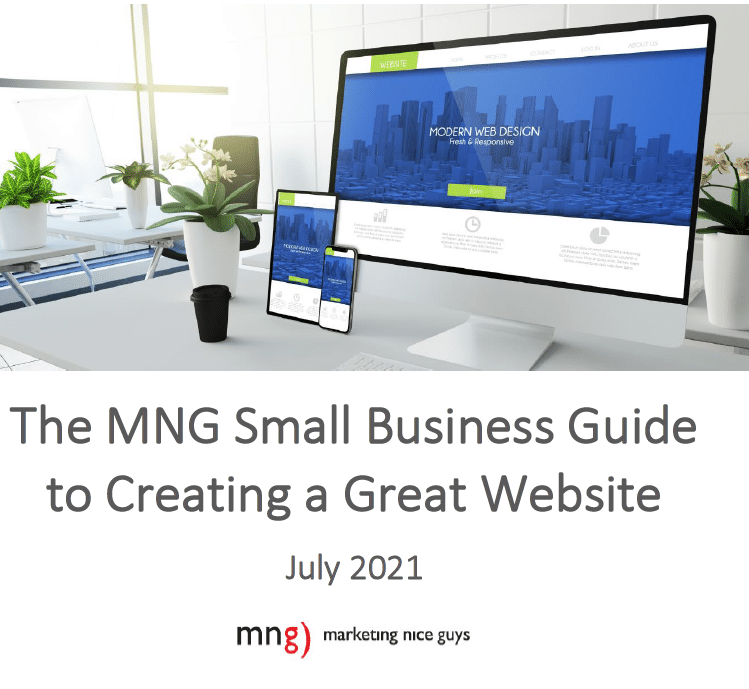For many small businesses, a website serves as the central foundation for most of the marketing that happens in digital (and even offline). Yet, despite that fact, sometimes it’s not evident when you look at many sites.
That’s not a knock against anyone who has sincerely tried to get a website up and launched themselves – it’s not easy, after all – but more of an observation of the priority it probably should take when it comes to getting your digital marketing right.
Over the course of the last few years, we’ve seen a number of small business websites that have made what could be termed “avoidable mistakes.” And not just in terms of design but in other critical areas. Here are eight mistakes that we hope are helpful to point out as you look to maximize this key marketing channel.
Mistake No. 1: Your Website Doesn’t Project a Consistent Look or Brand
A lot of small businesses underestimate the power of a visual first impression. When a visitor lands on your site (either from their phone, tablet, or desktop), some research suggests it only takes them .05 seconds to get a first impression – one that determines whether or not they’ll stay. if they don’t like it, they’ll leave. That means it’s critical that the company projects its visual brand well. And does so consistently. An overwhelming amount of text, color, or too much going on is a dead giveaway that it’s probably not worth staying.
A few things you can do:
- Limit your colors and fonts and strive to create a site with a strong overriding single color that represents your brand.
- From a design perspective, emphasize key elements that focus the eye and have what’s known as a strong visual weight – and stand out on a page. Don’t use too many either. (More on the concept of visual weight here.)
- Be rigorous in your in reinforcing your brand messaging and projecting a narrative that aligns with who you are and what your customers can expect.
Mistake No. 2: Your Website Is Frozen in Another Era
To this day, we still see many small business websites (and even some larger organizations) that look like they could’ve been developed in the early days of the Internet. And mostly, that’s because the small business owners never really felt the urge to update the look and feel or they just found it too difficult to keep up with the changing technology or found it too frustrating to work on the first one that they have little desire to go through it again. Regardless of the reason, we’re now in 2022. There’s really little excuse to have a website that isn’t airy/well-designed, and responsive for a mobile device. (Or, in some cases, mobile-first.)
A few things you can do:
- Commit to upgrading your website. If you want to do it yourself, in most cases, a simple WordPress site will do. You can choose from thousands of modern-looking themes (templates) – ones that probably work for your business and are easy to implement.
- If you don’t want to do a site yourself, hire someone who can do it for you and show you how to update it yourself. It’s not hard. And in most cases, can be done inexpensively (under $10k for most sites). For small sites with limited content, you can probably hire an agency to do them for $5k or less! Either way, it’s worth the investment of time and money. If you need help, contact us at Marketing Nice Guys for a free consultation on our affordable website services.
Mistake No. 3: Your Website Contains Typos and Errors
OK, is it the end of the world if you have a typo on your website? No, not at all. Let’s face it, with so much copy that you have to create, you’re bound to have a few. We do. (Boney, the co-owner of Marketing Nice Guys, is notorious for adding typos into everything he writes!!) Even sites with copy editors working full-time have typos.
But here’s the thing: If you have a lot of mistakes – grammatical or otherwise – in your copy on a regular basis, it’s a sign that you don’t pay attention to details or you’re seen as not as professional at what you do. After all, small mistakes in wording can affect your brand perception. And multiple errors also can affect the authority of your site in search engines such as Google.
A few things you can do:
- First, create an editorial process for the content you put out on the site. Even if you don’t have a copy editor and you are the sole copy creator, have a second pair of eyes look at it. Or read what you write and then read it a second time, as if you were copy editing it. That should help eliminate the majority of errors.
- Second, install Grammarly or another desktop application that can help you catch and flag grammatical errors as you type them into the site. It’s a great tool that we use. And it’s free!
The MNG Small Business Guide to Creating a Great Website Free Download
Fill out the form to download “The MNG Small Business Guide to Creating a Great Website.”
The guide will be emailed to you.

Mistake No. 4: Your Website Focuses on You, Not Your Customers
It’s not uncommon for a lot of businesses to approach their websites as simply an extension of themselves. What often happens, as a result, is that sites mirror internal organizational structures (especially navigation) and you get a lot of the following:
-
- “Here’s what we offer”
- “Here’s what we call things”
- “Here’s how we refer to our business and the industry terms”
This is fine if there is a common understanding with the customer about what a company does and the products and services it offers. But that’s rarely the case, as customers are often land on sites and look for solutions that pertain to them:
-
- “What do I need?”
- “How do I fix my challenges?
- “What products/services do I look for, using my nomenclature?”
- “What terms do I use?”
As you can see, the two don’t always line up unless you take a more focused effort at putting yourself in the shoes of the customer.
A few things you can do:
-
- Take a look at your navigation from the perspective of a customer. Do you simply mirror your internal structure? Or do you make it such that it focused on the key things the customers are actually looking for? If it’s not the latter, change the labels and the URLs to match those key customer areas.
- Take a look at how you’re promoting the products and services you have. Are you simply stating the features? You may want to better communicate the customer benefits, especially the emotional benefits of them using your product or service.
- Do some additional research on customer challenges and create pages aimed at talking about how you solve them. This does two things: 1. It establishes your authority in the field, and; 2. It can help you drive additional eyeballs because you’re creating relevant content that can be searched.
Mistake No. 5: It’s Hard to Transact on Your Website
In this case, by “transact,” we mean filling in a lead if you’re a sales-based organization or purchasing or registering for something if you are a more e-commerce, retail, or education provider. Typically, the biggest mistakes we see here involve simple user-experience problems – process flows, multiple confusing steps, or forms that are too long. Sometimes, it’s also speed that’s the big issue. (See no. 7).
A few things you can do (and we’ll separate these out in different buckets of e-commerce versus lead generation):
-
- E-Commerce: First, make it easy to put something in a cart and then take the next step to start the check out. Oftentimes, we find that sites overcomplicate everything in their effort to increase the average order value in that they put messages in front of individuals asking them if they want to keep shopping after they add something to the cart. We would always do the first thing first, get them to the cart. And then see if they want to add products or services.
- E-Commerce: Shorten the required fields in your forms. The more required fields you have the more frustrating it is for people who fill in their basic information. For example, in most cases, you don’t need the Address 2 field at all. (See more on this in our post: The 5 Marketing Optimizations You Should Be Making Right Now.)
- Lead Generation: Understanding that many companies want to qualify a lead as much as possible, it’s much better to err on keeping the number of fields as limited as possible (similar to the e-commerce bullet above), especially when it comes to downloading a content asset/lead magnet or for potential customers who inquire about products or services. Typically, you don’t need much beyond: name, email, and title/company. Another tip: Send an automated email confirmation as any first follow-up. You can also use that email to have registrants access a particular content asset or provide guidance on next steps.
Mistake No. 6: Your Website Isn’t Storing Data or Connected to a CRM/MAS
When we talk about automation in terms of a website, we’re mostly referring to the ability to have your website connected to a CRM or an email marketing automation platform: For example, you definitely should automate any messages in response form fills such as registrations, inquires, downloads and make sure that email comes from your marketing automation/email platform. But not only that. You should also make sure such activities are stored in your marketing automation platform and/or your CRM so you can use that data to better market (in a more personalized way) to those individuals.
One thing you can do: For a lot of small businesses, it’s not easy to set this up on your own. We recommend hiring a marketing agency (like ours!) that can do a one-time setup and configuration of your forms such that you can automatically store data in a marketing automation/email platform and automate some basic messages to start. Learn more about our marketing automation services here and request a free consultation.
Mistake No. 7: Your Website Is Slow, Dead Slow
Customers and potential customers are impatient. Often, when a website takes more than a few seconds to load, visitors will simply just abandon the effort. Typical issues here include:
-
- Large sized images on pages that have been optimized or reduced in size
- Large images that are squeezed into smaller spaces and don’t fit the more exact dimensions of the image placement
- Extraneous JavaScript or unnecessary CSS
- Long pages that aren’t enabled for a lazy-load
One thing you can do: We always recommend that clients test any page in Google’s PageSpeed Insights: https://pagespeed.web.dev/. Just enter the URL you want to test and run the analysis. Afterward, provide the results to your developers and/or content managers and see if they can make adjustments that boost your speed into at least an “average” rating.
Mistake No. 8: Your Website Isn’t Optimized for Search
There are so many small businesses that lose potential opportunities because their pages don’t show up in search engines. And while search engine optimization can be complex, some basic fundamentals are often not followed, including:
-
- Repeating high-value keywords in the URL, the title tag, headlines, body copy, and image URLs, and image alt text.
- Maintaining at least 5 internal links to every page on the website.
- Making sure the site loads quickly (as mentioned above) and provides a good experience in mobile in particular.
- Working to create links to pages from social and quality inbound links from high-value websites including directories, publisher sites, or industry-related organizations.
A few things you can do:
-
- First, make sure to download our SEO Checklist for Copywriters. It will help you as you create content for any page.
- Second, if you need more help, contact us for an SEO audit for your site. We’ll take a detailed look at your on-page website ranking factors, your competition, inbound links, the keywords related to your business, and more.
Conclusion
We hope this has been helpful. As always, our mission is to help you as an individual or a business excel at digital marketing. If you need additional help, don’t hesitate to contact us for a free consultation. We’ll be happy to discuss your marketing needs and how we might be able to help.






